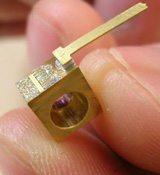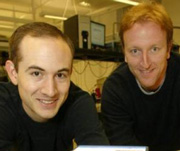

| Home | About Us | Contribute | Bookstore | Advertising | Subscribe for Free NOW! |
| News Archive | Features | Events | Recruitment | Directory |
| FREE subscription |
| Subscribe for free to receive each issue of Semiconductor Today magazine and weekly news brief. |
News
5 January 2009
Princeton reports new lasing mechanism in quantum cascade laser
A team led by researchers in Princeton University’s Department of Electrical Engineering has discovered what is claimed to be an entirely new mechanism for making common electronic materials emit laser beams after fabricating a quantum cascade laser that generates a second beam with very unusual properties, including the need for less electrical power than the conventional beam (‘High k-space lasing in a dual-wavelength quantum cascade laser’, Nature Photonics vol 3 (2008), p50; doi:10.1038/nphoton.2008.250).
 Unlike conventional semiconductor lasers, quantum cascade lasers operate in the mid- and far-infrared range, and can be used to detect minute traces of water vapor, ammonia, nitrogen oxides, and other gases that absorb infrared light. Quantum cascade lasers are hence finding applications in environmental air quality monitoring, medical diagnostics, homeland security, and other areas that require extremely sensitive detection of different chemicals. The new discovery could help to make these devices smaller and more sensitive, as well as operating more efficiently and at higher temperatures than existing devices.
Unlike conventional semiconductor lasers, quantum cascade lasers operate in the mid- and far-infrared range, and can be used to detect minute traces of water vapor, ammonia, nitrogen oxides, and other gases that absorb infrared light. Quantum cascade lasers are hence finding applications in environmental air quality monitoring, medical diagnostics, homeland security, and other areas that require extremely sensitive detection of different chemicals. The new discovery could help to make these devices smaller and more sensitive, as well as operating more efficiently and at higher temperatures than existing devices.
Picure (above): A quantum cascade laser. Credit: Frank Wojciechowski.
“This discovery provides a new insight into the physics of lasers,” says lead researcher Claire Gmachl, electrical engineer and director of the Mid-Infrared Technologies for Health and the Environment (MIRTHE) center, a multi-institutional research collaboration for developing compact sensors to detect trace amounts of gases in the atmosphere and in human breath (funded by the US National Science Foundation, which partly sponsored the research). Partial support was also provided by the European Union’s Marie Curie Research Training Network and its Physics of Intersubband Semiconductor Emitters (POISE) program, which sponsored the visit to Princeton of Stefan Menzel, a graduate student from the UK’s University of Sheffield, who unearthed the unique properties of the phenomenon during an internship last summer. The team also included Gmachl’s graduate student Kale Franz (supported by the NSF Graduate Fellowship Program), who used Princeton’s nanofabrication facility to make the quantum cascade laser that revealed the new phenomenon.
In an earlier study (published in Applied Physics Letters in June 2007), Franz, Gmachl and others had reported that a quantum cascade laser they had fabricated unexpectedly emitted a second laser beam of slightly smaller wavelength than the main beam. Further studies by Menzel and others revealed that the second beam could not be explained by any existing theory of quantum cascade lasers. Unlike a conventional semiconductor laser, the second beam grew stronger as the temperature increased, up to a point. Further, it seemed to compete with the ‘normal’ laser, growing weaker as the latter strengthened when more electric current was supplied. “It’s a new mechanism of light emission from semiconductor lasers,” says Franz.
To explain this mechanism, the researchers invoked a quantum property of electrons. In the conventional view of semiconductor lasers, because of the propensity of charge carriers to undergo extremely fast momentum relaxation, they accumulate at energy band extrema, and only electrons of nearly zero momentum (with a small wavevector close to k=0 in direct-bandgap semiconductors) participate in lasing. Conventional understanding suggests that device-level physics (including population inversion for lasing in diode lasers, interband cascade lasers and quantum cascade lasers) occurs at these energy band extrema. Further, a substantial number has to attain the same level of energy and momentum (in a quasi-equilibrium condition) before they can participate in lasing.
 In contrast, studies by Gmachl’s group showed that the new QCL has an energy configuration that is able to establish local population inversion high in k-space, so the second laser beam originates from electrons of lower energy but higher momentum that were not in equilibrium. “It showed, contrary to what was believed, that electrons are useful for laser emission even when they are in highly non-equilibrium states,” says Franz.
In contrast, studies by Gmachl’s group showed that the new QCL has an energy configuration that is able to establish local population inversion high in k-space, so the second laser beam originates from electrons of lower energy but higher momentum that were not in equilibrium. “It showed, contrary to what was believed, that electrons are useful for laser emission even when they are in highly non-equilibrium states,” says Franz.
Picture (above): Kale Franz (left) and Stefan Menzel (right).
The new laser phenomenon has some interesting features. For instance, in a conventional laser relying on low-momentum electrons, electrons often reabsorb the emitted photons, reducing overall efficiency. In the new type of laser, however, this absorption is cut by 90%, says Franz. This could potentially allow the device to run at lower current, and also makes it less vulnerable to temperature changes. “It should let us dramatically improve laser performance,” he adds.
The device used in the study does not fully attain this level of performance since, of the dual-wavelength emission observed from the two discrete optical transitions (the conventional quantum cascade laser transition at k=0 and the other laser transition from electrons at high k), the conventional, low-efficiency k=0 mechanism dominates. Temperature-dependent performance attributes show that the two transitions are highly coupled; competition for charge carriers is apparent from the anti-correlated behavior. “If we can turn off the conventional beam, we will end up with a better laser, which makes more efficient use of electrical power,” Gmachl says. The researchers have started to work on methods to achieve, adds Franz.
See related items:
Magnetic QCL emits 3THz at 225K and 0.68THz at 8K
First room-temperature semiconductor source of coherent terahertz radiation
![]() Search: Quantum cascade laser
Search: Quantum cascade laser
Visit: http://engineering.princeton.edu
